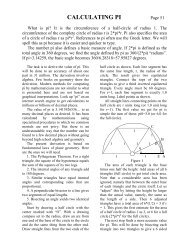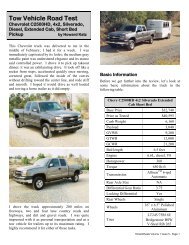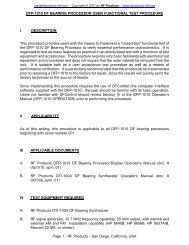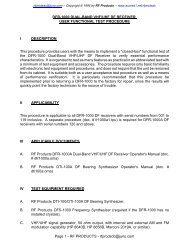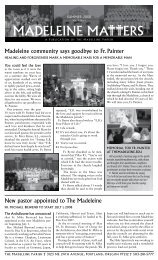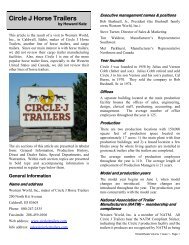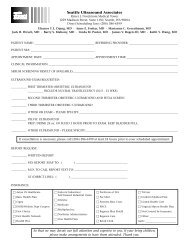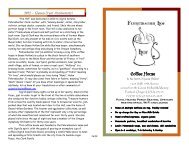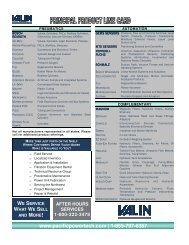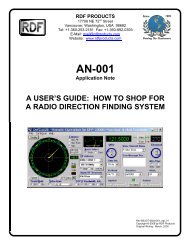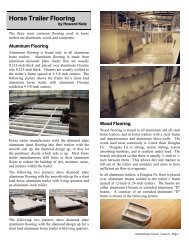DPX100
DPX100
DPX100
Create successful ePaper yourself
Turn your PDF publications into a flip-book with our unique Google optimized e-Paper software.
<strong>DPX100</strong>Full Flow Sharingsectional valve
<strong>DPX100</strong>Additional informationThis folder shows the product in the most standard configurations.Please contact Sales Dpt. for more detailed information or specialrequest.WARNING!All specifications of this folder refer to the standard product at thisdate. Walvoil, oriented to a continuous improvement, reserves theright to discontinue, modify or revise the specifications, withoutnotice.WALVOIL IS NOT RESPONSIBLE FOR ANY DAMAGE CAUSED BY ANINCORRECT USE OF THE PRODUCT.D1WWDD01A
<strong>DPX100</strong>Features• Load Sensing technology for higher efficiency, reduced energy consumption andlonger system lifetime.• Flow Sharing technology: in case of system saturation, flow to each actuator isproportionally reduced.• Control options: manual, hydraulic, electric (on/off), electrohydraulic (proportional);all in common with SDS100 valve.• Open centre for fixed displacement pump applications.• Closed centre for variable displacement Load Sensing pump applications.• Special options for vehicle applications.D1WWDD01A
<strong>DPX100</strong>Operational principleIntroductionThe <strong>DPX100</strong> control valve adds to the standard Load Sensing valve the benefit of Flow Sharing technology. The <strong>DPX100</strong> patentedcompensator maintains the margin pressure as a costant pressure drop across the spool metering area. The result is a flowto the workport dependent only on spool position. In case of flow saturation, the effective pressure drop across all spools isreduced equally. This results in proportional flow reduction at each section.Single section operation: refer to picture 1picture 1The main flow enters from the inlet line. crosses the meteringarea to the compensator and enters the bridge. The spool selectsflow to workport A (as shown), performing work at the actuatorwith return flow to workport B, crossing spool metering as it passesto tank.With only one section active, the imbalanced compensator fullyshifted to the right giving priority control to either the <strong>DPX100</strong>inlet compensator (fixed displacement pump) or to the pumpcompensator (variable displacement pump) which provides spoolstroke proportional flow. This action drives the piston and selectorsphere to the right. The piston rod prevents the selector spherefrom seating, allowing flow to the load sensing line.Multi-section operationWhen two functions are working at the same time, the higher pressure function is dominant. The dominant valve section performsas described in “ single section operation”. The function at lower pressure becomes a dependent section.picture 2• Dependent section (with lower load): refer to picture 2In the dependent section, function pressure is sensed in thespring chamber of the piston. The higher load sense pressure fromthe dominant section is sensed at the piston rod end, pushing thepiston to the right. At the same time, load sense pressure pushesthe compensator left, separating the piston and compensator.The compensator metering notches are now working in order tocreate an artificial pressure drop that will add to the lower load.The pressure drop across the spool metering area will then remainequal to the margin. This will guarantee the flow to be only a functionof the spool position.D1WWDD01A
<strong>DPX100</strong>Operational principle• Flow Sharing conditionIn case of flow saturation, the flow demand is higher than the maximum pump flow therefore the margin pressure is reducedaccording to the formula:QαA∆PρSince all spools have the same pressure drop across the metering area, then all flows are reduced proportionally. This allowsthe operator to mantain control of all function, though at reduced speed of active functions.picture 3• Compensator as check valve: refer to picture 3When actuator or function pressure is higher than inlet pressure,the group formed by the compensator, selector sphere and pistonwork together as a check valve. Workport pressure in the springchamber of the piston is higher than inlet pressure, resulting inthe entire group moving to the left. The movement seats thecompensator against the left plug. The passage between inlet andworkport bridge is now closed, preventing backflow from the actuator.Moreover the load sensing flow is generated by the pumpand is not taken from the workport, preventing backflow from theactuator.Advantages of <strong>DPX100</strong>• Energy saving on closed centre system, is produced only required flow and pressure by the actuators.• Flow sharing allows predictability of movement even during multi-function operation.• Flow passage design allows high P and T flow rate in a standard valve dimension.D1WWDD01A
<strong>DPX100</strong>Working conditionsThis catalogue shows technical specifications and diagrams measured with mineral oil of 46 mm 2 /s - 46 cSt viscosity at 40°C- 104°F temperature.Nominal flow ratingOperating pressure (max.)inlet port with compensator (stand-by 14 bar- 200 psi)120 l/min 32 US gpmworking ports (stand-by di 14 bar - 200 psi) 90 l/min 24 US gpminlet port P 300 bar 4350 psiworking ports A and B 300 bar 4350 psiBack pressure (max.)on outlet port T30 bar (10 bar with manualsection)435 psi (145 psi withmanual section)Internal leakage A(B)⇒T∆p = 100 bar - 1450 psi fluid and valve at40°C - 104°Fmax. 9 cm 3 /minmax. 0.55 in 3 /minFluidMineral based oilFluid temperaturewith NBR (BUNA-N) seals from -20°C to 80°C from -4°F to 176°Fwith FPM (VITON) seals from -20°C to 100°C from -4°F to 212°Foperating range from 15 to 75 mm 2 /s from 15 to 75 cStViscositymin. 12 mm 2 /s 12 cStmax. 400 mm 2 /s 400 cStMax contamination level -/18/15 - ISO 4406 NAS 1638 - class 9Ambient temperature forworking conditionswith mechanical devices from -40°C to 60°C from -40°F to 140°Fwith pneumatic and hydraulic devices from -30°C to 60°C from -22°F to 140°Fwith electric devices from -20°C to 50°C from -4°F to 122°FNOTE - for different conditions please contact Sales Dpt.Standard threadsREFERENCE STANDARDBSP UN-UNF METRIC METRIC ISO NPTFTHREADACCORDING TOISO 228/1 ISO 263BS 2779ANSI B1.1 unifiedISO 262 ISO 262 ANSI B1.20.3CAVITYDIMENSIONACCORDING TOISO 1179 11926 9974-1 6149SAE J1926 J2244 J476aDIN 3852-2 shape X or Y 3852-1 shape X or YPORTSMAIN PORTS BSP UN-UNF METRIC PILOT PORTS BSP UN-UNF METRICInlet P G 1/27/8-14(SAE10)M22x1.5 Hydraulic pilots G 1/47/16-20(SAE4)M14x1.5Ports A and B G 3/8 3/4-16 (SAE8) M18x1.5 Pneumatic pilots NPTF 1/8-27Outlet T G 1/27/8-14(SAE10)M22x1.5Pilot V and drain L G 1/49/16-18(SAE6)M14x1.5NOTE - for different port size contact Sales Dpt.D1WWDD01A
<strong>DPX100</strong>Performance dataGeneralPressurePressure drop inlet compensator0 6 12 18 24 30 (US gpm)40(psi)(bar)500304002010000 20 40 60 80 100 120Flow(l/min)300200100PressureA(B) ⇒ T pressure drop0 6 12 18 24 30 (US gpm)40(psi)(bar)500630a section40012 a section203001 a section 20010100000 20 40 60 80 100 120Flow (l/min)Spools metering curvesQin = 90 l/min - Open centre circuitWith compensator features shown above0 0.05 0.1 0.15 0.20 0.25 (in)100(US gpm)(l/min)2480 l/min - 21 US gpm8070 l/min - 18 US gpm186060 l/min - 16 US gpmFlow4020000 1 2 3 4 5 6 7Stroke(mm)12650 l/min - 13 US gpm40 l/min - 11 US gpm30 l/min - 7.9 US gpm20 l/min - 5.3 US gpm10 l/min - 2.6 US gpmPressurePressure relief valveSetting example (230 bar - 3350 psi)0 5 10 15 20 (US gpm)400(psi)(bar)5000300400020010000015 30 45 60 75 90Flow(l/min)300020001000Auxiliary valvesFlowPort valves type USetting example (10 l/min - 2.6 US gpm)0 5 10 15 20 (US gpm)400(psi)340 bar / 4950 psi(bar)5000310 bar / 4500 psi300200100260 bar / 3750 psi200 bar / 2900 psi140 bar / 2050 psi80 bar / 1150 psi25 bar / 360 psi00 15 30 45 60 75 90Stroke(l/min)40003000200010000Pressure0 5 10 15 2020(bar)1510Type U valves pressure drop(in anticavitation)5000 15 30 45 60 75 90Flow(l/min)(US gpm)(psi)25020015010050D1WWDD01A
<strong>DPX100</strong>Dimensional data and hydraulic circuitManual / hydraulic control configurationEF47,251.86230,554 9.0713046,52.1246,5 45,5 391.8336,51.83 1.79 1.531.4430 331.18 1.30301.18TA1B1A2B2T2M8 assemblingholes602.36351.3827,11.0719, 50.77LSP118°018°36 361.42 1.4247.51.87431.6918,10.711114.372NOTE: Drawings and dimensions are referred to BSP thread configuration.TIPOEFmm in mm in<strong>DPX100</strong>/1 144 5.67 90,5 3.56<strong>DPX100</strong>/2 180 7.09 126,5 4.98<strong>DPX100</strong>/3 216 8.50 162,5 6.40<strong>DPX100</strong>/4 252 9.92 198,5 7.81<strong>DPX100</strong>/5 288 11.34 234,5 9.23<strong>DPX100</strong>/6 324 12.76 270,5 10.65TIPOEFmm in mm in<strong>DPX100</strong>/7 360 14.17 306,5 12.07<strong>DPX100</strong>/8 396 15.59 342,5 13.48<strong>DPX100</strong>/9 432 17.01 378,5 14.90<strong>DPX100</strong>/10 468 18.43 414,5 16.32<strong>DPX100</strong>/11 504 19.84 450,5 17.74<strong>DPX100</strong>/12 540 21.26 486,5 19.15D1WWDD01A
<strong>DPX100</strong>Description compositionManual / hydraulic control configurationNr. of sectionsLoad Sensing relief valve setting (bar)Port valves setting (bar)Flow on ports l/minElectric devices supplyvoltage<strong>DPX100</strong>/ 2 / A M1(TG3 - 120) / P-101(80/80)-8L.U1(100)U2(100) / P-101(80/80)-8L.U3T / RF - F - 12VDC12 3a 3A 4AInlet and outlet on inletselectionProportional electrohydraulic control configurationLoad Sensing relief valve setting (bar)Nr. of sectionsFlow on ports l/minElectric devices supply voltageTarature valvole ausiliarie in bar<strong>DPX100</strong>/2/A M1(TG3-120)/P-101(80/80)-8L/qe-e101(80/80)-8eb3l/PA-101(80/80)-8L.U1(90)U2(90)/rdR-F-12VDC12 3A3B3C4AInlet and outlet oninlet selection4B3A3AOptional handlever4B23C3B3a2Type PA working section(with pilot through anddrain lines)Asembling kitType QE working section(with pilot and drain lines forelectrohydraulic controls)Type Q standard section (withoutpilot through and drain lines)Asembling kit12 D1WWDD01A
<strong>DPX100</strong>Description composition1 Main inlet configurationA: Directional valve with LEFT inlet (standard)B: Directional valve with RIGHT inlet2 Complete inlet sectionM1(TG3-120): For open centre circuit with compensator, side inletP and LS ports, upper outlet T port, pressure relief valve on Loadsensing signalN1(TG3-120): As previous, with closed centre circuit, without compensatorM1(SU/TG3-120): For open centre circuit, with non-return flowlimiter from working section to inlet section and fixed setting by-passvalve for starting rampN1(SU/TG3-120): As previous for closed centreM1(SO/TG3-120): For open centre circuit, with non-return flowlimiter from working section to inlet section and by-pass valve forswing dampingN1(SO/TG3-120): As previous for closed centreM1(TG3-120)ELT: For open centre circuit with unloader valve onLoad Sensing signal (with “twist and push” operation)N1(TG3-120)ELT: As previous for closed centreM1(TG3-120/SB): For closed centre circuit with compensator forvariable displacement pump with minimum flow3A Complete working sectionQ-101(80/80)-8L: Without port valve arrangement, double actingspool with A and B closed in neutral position, lever control with springreturnP-101(80/80)-8L.U3T: As previous with arrangement for portvalves (valve seats plugged)P-101(80/80)-8L.U1(100)U2(100): As previous with antishockwith prefill valves on each portQ-101(80/80)-8L.BP3: Without port valve arrangement, doubleacting spool with A and B closed in neutral position, lever control withspring return, flange mounted check valvesP-101(80/80)-8L.U3T.BP3: As previous with port valves arrangement(valve seats plugged)Q-I101(80/80)-8IM: Without port valve arrangement, doubleacting spool with A and B closed in neutral position, proportionalhydraulic control with spring returnP-I101(80/80)-8IM.U1(100)U2(100): As previous with antishockwith prefill valves on each port4A Complete end coverRF: Arranged for upper T2 outlet (plugged)RF(04): Arranged for upper T2 outlet, side T1 outlet, P1 inlet, LS1Load Sensing and M1 pressure gauge (ports plugged)RF(01): Arranged for upper T2 outlet, side P1 inlet, side LS1 LoadSensing (ports plugged), with stand-by reductionRF(02): Arranged for upper T2 outlet, side P1 inlet, side LS1 LoadSensing (ports plugged), with electrically operated unloading valve3B Complete working sectionSection with pilot and drain lines for electrohydraulic controlsQE-E101(80/80)-8EB3: Without port valve arrangement, doubleacting spool with A and B closed in neutral position, double side proportionalelectrohydraulic controlPE-E101(80/80)-8EB3.U3T: As previous with arrangement forport valves (valve seats plugged)PE-E101(80/80)-8EB3.U1(100)U2(100): As previous with antishockwith prefill valves on each portQE-E101(80/80)-8EB3.BP3: Without port valve arrangement,double acting spool with A and B closed in neutral position, doubleside proportional electrohydraulic control, flange mounted checkvalvesPE-E101(80/80)-8EB3.U3T.BP3: As previous with port valvesarrangement (valve seats plugged)QE-E101(80/80)-8EB3LH: Without port valve arrangement, doubleacting spool with A and B closed in neutral position, double side proportionalelectrohydraulic control and leverPE-E101(80/80)-8EB3LH.U3T: As previous with arrangement forport valves (valve seats plugged) with lever3C Complete working sectionSection with pilot through and drainQA-101(80/80)-8L: Without port valve arrangement, double actingspool with A and B closed in neutral position, lever control with springreturnPA-101(80/80)-8L.U1(100)U2(100): As previous with antishockwith prefill valves on each port4B Complete end coverRDN-NOTAP(VL): Without pressure reducing valve, external pilot Vand drain L (ports open), arranged for side T1 outlet (plugged)RDN(03)-NOTAP(VL): Without pressure reducing valve, externalpilot V and drain L (ports open), arranged for side T1 outlet, side P1inlet and LS1 Load Sensing (ports plugged)RDR: With pressure reducing valve, internal pilot and drain, arrangedfor side T1 outlet (ports plugged)RDR(03): With pressure reducing valve, internal pilot and drain,arranged for side T1 outlet, side P1 inlet and LS1 Load Sensing (portsplugged)D1WWDD01A13
D1WWDD01A - 3 rd edition March 2010WWW.WALVOIL.COM



